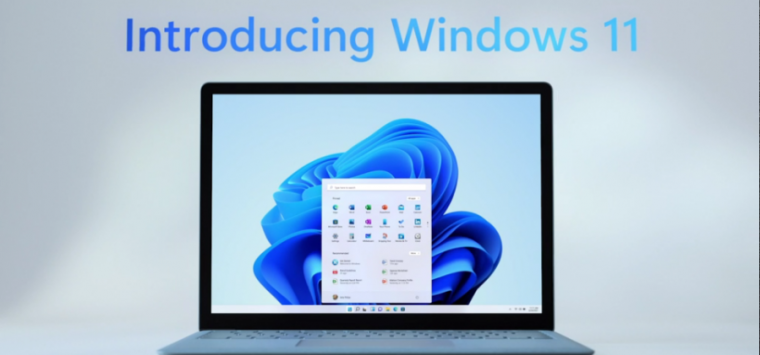
Earlier this morning, we got our first official look at Windows 11 by way of Microsoft's What's New For Windows event. The new OS offers several significant, functional changes to what we've become accustomed to in Windows 10—this isn't just the same old operating system with a fresh coat of paint.
However, Windows 11 absolutely does get that fresh coat of paint. Its new desktop environment makes heavy use of translucent window dressing with rounded corners, an effect that brings to mind panes of frosted glass. In many ways, the new look is reminiscent of compiz-based Linux desktop environments circa 2010—but with significantly higher resolution and a more coherent overall theme.
Microsoft Chief Product Officer Panos Panay ties the new look to eyebrow-raising statements about emotion: "We understand the responsibility of [functionality and practicality] more than ever before, but it must also be personal—and maybe most importantly, it must feel emotional."
We doubt anyone but Panay will get misty-eyed about the new look—but the ubiquitous translucent borders do serve to reassure users that their real work is still present, untouched, behind pop-up elements such as the new personalized widget feed.
A new start menu—and separate newsfeed
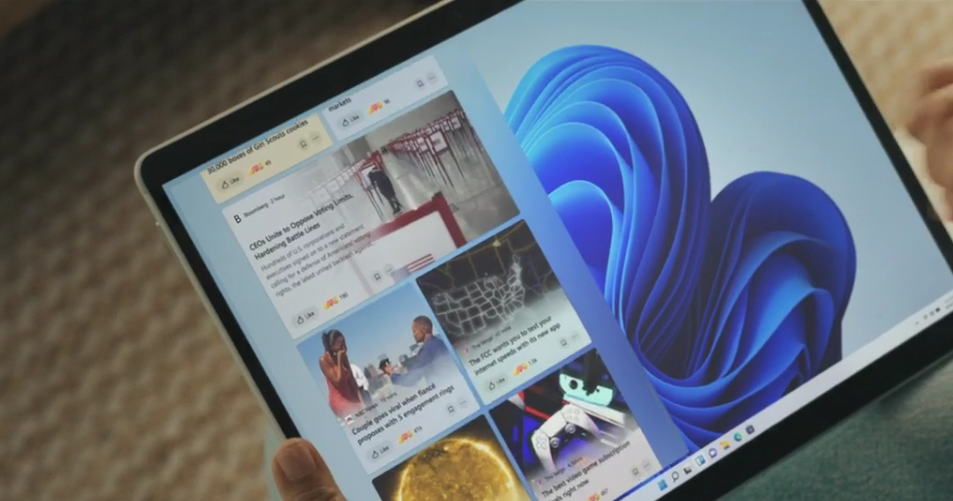 This action shot shows off the AI-powered, widget-populated newsfeed—notice that it pops up from the left, completely separate from the center-popping Start menu.
This action shot shows off the AI-powered, widget-populated newsfeed—notice that it pops up from the left, completely separate from the center-popping Start menu.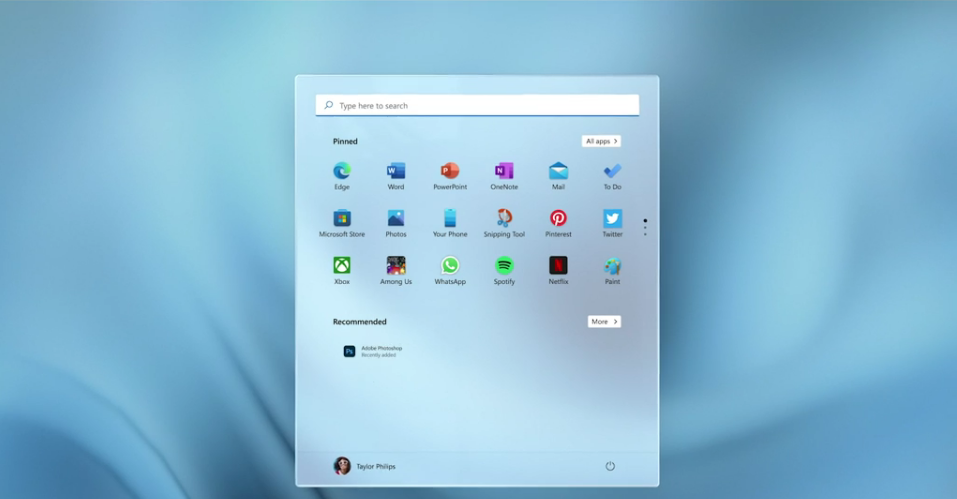 The new Start menu pops up from the center of the taskbar by default, displaying a row-oriented app icon cluster and "recommended" document selection area beneath.
The new Start menu pops up from the center of the taskbar by default, displaying a row-oriented app icon cluster and "recommended" document selection area beneath.
Earlier versions of Windows experimented with introducing a newsfeed directly into the Start menu—a feature that few Windows users seemed to appreciate, and many utterly loathed. Microsoft clearly heard the latter, but the company isn't willing to give up on its own outside-the-browser newsfeed yet. In Windows 11, the newsfeed has been broken out into a separate dialog, similar to (but not a part of) the actual Start menu.
Panay dipped into "emotion" once again while describing the new Start menu and separate newsfeed—"it's what you need, closer to you, simplified," he said of the new center-located Start menu. The new Start menu uses space formerly occupied by newsfeed tiles to instead offer access to recently used documents and applications. "The details matter," Panay said of the new menu, going on to say, "It is the details that enable you to get to that emotional space... to get the work you need done."
The separate newsfeed—which opened from the left in Panay's demonstrations—is effectively those missing Metro-style tiles, now referred to by the more industry-standard term "widgets" and augmented with a top-mounted search bar. "How it all flows together is meant to bring you to an incredible sense of calm," Panay gushed.
“Also beautiful on the inside”
Before handing off to Microsoft Partner Director Carmen Zlateff, Panay spent a moment detailing why Windows 11 is "beautiful on the inside." This mostly meant ticking off performance improvements in Windows—improvements for which we unfortunately have no concrete metrics.
- Faster wake from sleep
- Faster Windows Hello biometric authentication
- Faster browsing on Microsoft Edge
- "Browsing on any browser is faster, actually, which is awesome"
- Windows Updates are 40 percent smaller, more efficient, and "happen in the background"
- Decreased energy use, for longer battery life, which Panay describes as making Windows 11 "more responsible"
- "Maybe most important, Windows 11 is the most secure Windows yet"
As important as this laundry list of improvements sounds, Panay unfortunately went into no detail about them. We do not know why "browsing on any browser is faster," and we don't know why Windows 11 should be considered "the most secure Windows yet."
Significantly updated task management
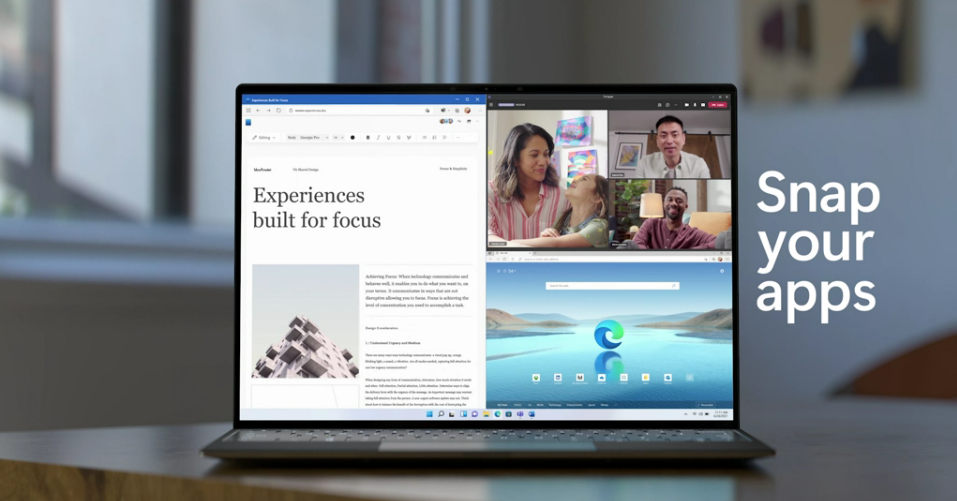 Snap layouts look like a great functional interface upgrade, particularly for laptop users—in this shot, we see three applications snapped into one of the available layouts.
Snap layouts look like a great functional interface upgrade, particularly for laptop users—in this shot, we see three applications snapped into one of the available layouts.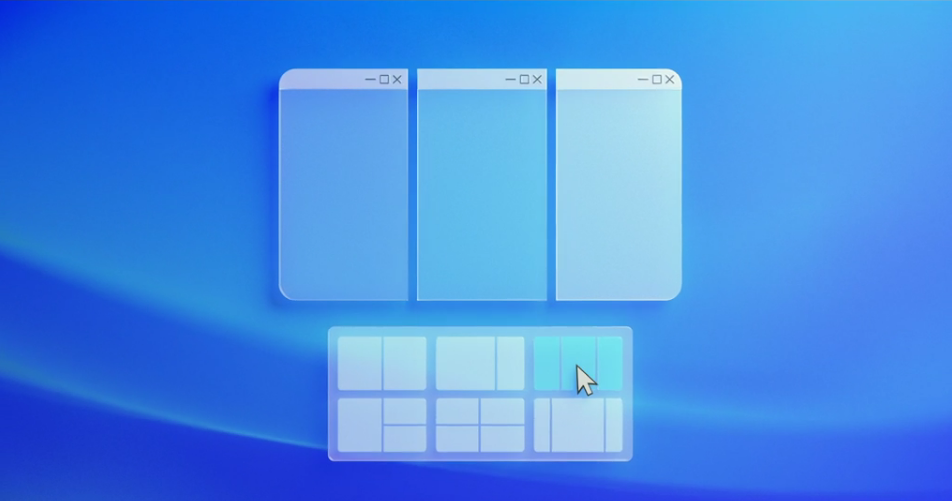 Windows 11 users will be able to select one of several snap layouts based on the size and orientation of their display. Apps then snap into the selected layout and can be dragged from one position to the next.
Windows 11 users will be able to select one of several snap layouts based on the size and orientation of their display. Apps then snap into the selected layout and can be dragged from one position to the next.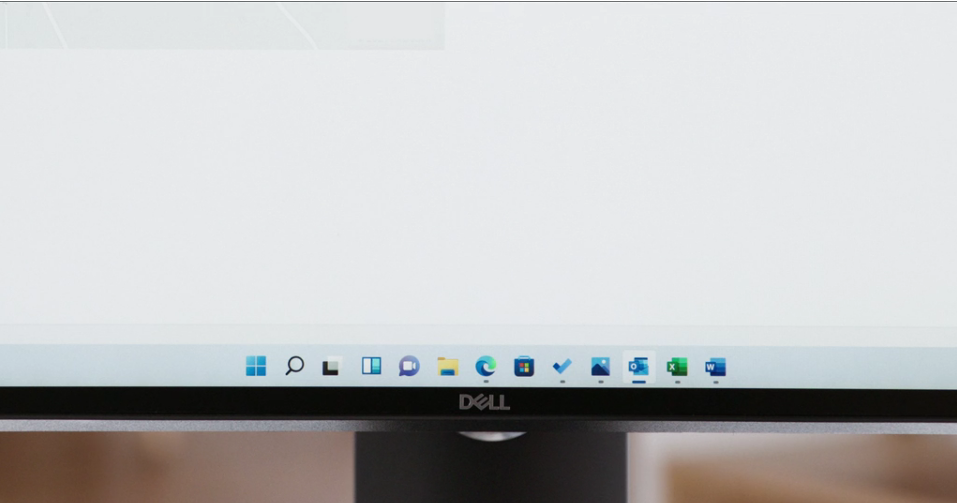 Once a snap layout is populated with apps, the whole thing can be tied together as a snap group. The connection between apps in snap groups is visible in this close-up of the new taskbar.
Once a snap layout is populated with apps, the whole thing can be tied together as a snap group. The connection between apps in snap groups is visible in this close-up of the new taskbar.
Zlateff introduced two major new-to-Windows task management and switching features: snap layouts, and virtual desktops. Snap layouts will be familiar to anyone who's tried a tiling desktop environment—they amount to a way to snap multiple applications into a fixed, screen-efficient tiled layout.
Windows 11's tiling implementation appears smart, and Zlateff said it's tied directly to the screen orientation and resolution. The user can select a layout and then drag apps into the fixed borders offered by the layout—we saw a selection of six available layouts, each of which supports from two to six window locations.
Building onto snap layouts, Zlateff demonstrated snap groups—these are groups of applications that have been snapped into one of the tiled layouts and can be brought up or sent down from the taskbar as a group. The Linux users among you are probably thinking, "So, snap groups are Microsoft's take on virtual desktops"—but Windows 11 also supports Linux-style full virtual desktops as a separate feature. (For the non-Linux-y reader: virtual desktops are separate "screens" full of applications; clicking the button for one "screen" clears the monitor entirely and loads that "screen's" collection of windows.)
The new snap groups can be selected with a single taskbar click, just as individual apps are raised and lowered—and right alongside the individual apps themselves, which can also be raised and lowered alongside the groups. Zlateff described this ability to switch between individual apps or between "entire projects" as something that can only be done on Windows.
Finally, support for docking and undocking laptops appears greatly improved. Zlateff demonstrated apps rearranging themselves to a single-display layout as a laptop's second external monitor is removed. But more importantly, Zlateff showed apps flowing back exactly as they had been once the display was reconnected.
Improved tablet mode and alternate input
Microsoft Communications Manager Phillip McClure introduced Windows 11's updated input modes by saying, "Windows [11] without a keyboard adapts to you, instead of the other way around." This largely translates to bigger touch targets and subtle visual cues that make tablet mode on McClure's two-in-one touchscreen laptop simpler to use but without significantly altering the look and feel of Windows itself.
Windows 11 alternate input features include:
- Updated pen support—McClure briefly demonstrated highlighting lines of text with a stylus, while discussing all-new stylus haptic feedback.
- A brand-new touch keyboard—theme-able, supports swiping, located optimally, and clearly designed for one-thumb typing in tablet mode, uses space bar as cursor control for text selection.
- Updated voice recognition—a brief demonstration shows support for automatic punctuation (e.g., rising tone gets a question mark) and inline voice commands (e.g., "delete that" while dictating).
- Wireless television "projection"—apparently similar to mobile phone "casting" to smart TV or Chromecast. No real details have been given.
McClure also brings us back to the AI-powered widget feed. In a brief demonstration, he tells us that the clear separation between news feed and real applications allows him to "check stuff without disturbing his workflow."
Gaming on Windows 11
Head of Game Creator Experience Sarah Bond outlined several new gaming-related features in Windows 11:
- Auto HDR—this feature, originally introduced on Xbox, expands games' lighting and color to a higher dynamic range. Bond demonstrated Auto HDR on Skyrim in a live left/right split display; the effect is strongly reminiscent of the automatic adjustment filters found in mobile camera and photo applications.
- DirectStorage—this Xbox feature allows game assets to stream directly to the GPU, with greatly reduced CPU impact.
- Xbox Game Pass—this subscription program gives members access to a large gaming library, currently "100+" games including first-day launches of games from Xbox Game Studios and Bethesda, all of EA Play, and third-party titles from both small and large developers.
- Cross-play and cross-save—supported games can be played "seamlessly across devices" with a global community of millions of players. This includes a player saving the game on one platform, then resuming it on another.
Games can be purchased directly through the Xbox app—which seems to be taking direct aim at Valve's Steam platform, with similar appearance and features.
Improved Microsoft Store—now including Android apps
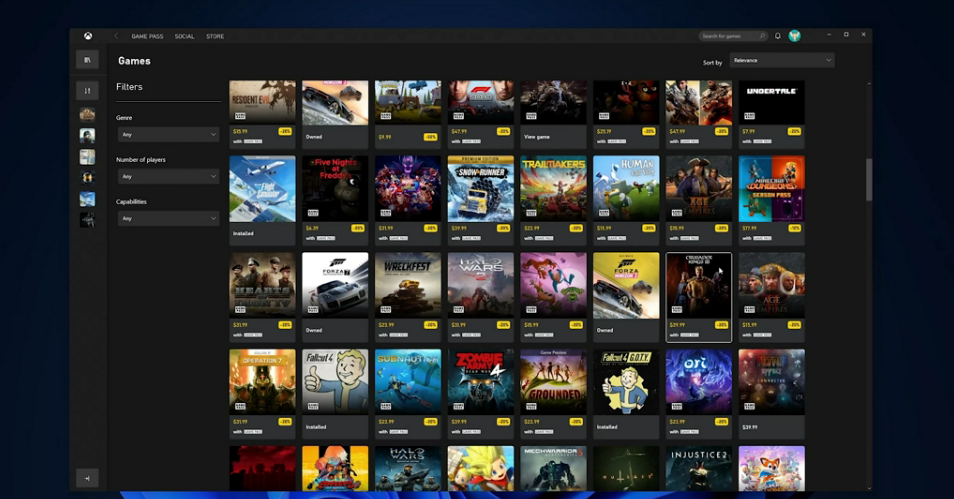 The Xbox app's game store will likely look familiar to anyone with a Steam account—and it functions similarly, serving as both store and application launcher.
The Xbox app's game store will likely look familiar to anyone with a Steam account—and it functions similarly, serving as both store and application launcher.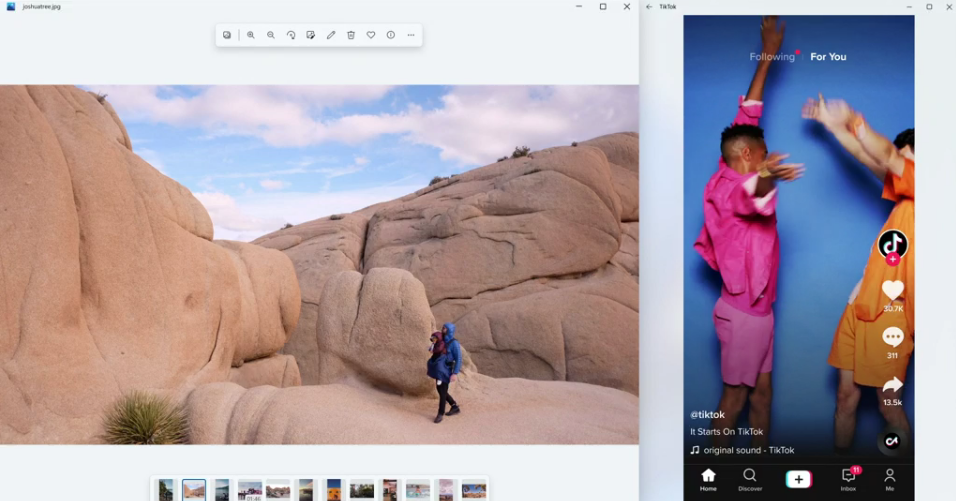 In this screenshot, we can see the TikTok app for Android snapped into a layout that looks like a Windows photo manager.
In this screenshot, we can see the TikTok app for Android snapped into a layout that looks like a Windows photo manager.
Windows 11's newly improved Microsoft Store is, according to Panay, "rebuilt from the ground up" and makes it easier for developers to host and sell Win32 apps, Progressive Web Apps, and Universal Web Platform apps side by side.
Microsoft is also changing the financial terms of its store—Panay describes the revamped store as offering "industry-leading revenue share" for developers. Interestingly, he also teased at the ability to "bring your own commerce engine"—though with no detail for how this integrates with the Store—adding that devs using their own commerce engines don't need to share any revenue whatsoever with Microsoft.
Finally—and perhaps most excitingly—the newly revamped Microsoft Store is offering access to Android applications. Panay described the Android environment as powered by Intel bridge technology, and it demonstrated several apps (including TikTok) running flawlessly in phone-shaped and tablet-shaped windows.
The Android apps themselves are "discoverable through the Microsoft Store using the Amazon app store." That accessibility was demonstrated with what looked like the same app store you'd see on a Fire HD tablet, reskinned for Windows 11 integration.
Developers interested in the new app store updates can attend a Microsoft Store deep dive later today, at 3 pm EDT.
"much" - Google News
June 25, 2021 at 01:07AM
https://ift.tt/35RqkEM
Windows 11 is much more than a new theme slapped onto Windows 10 - Ars Technica
"much" - Google News
https://ift.tt/37eLLij
Shoes Man Tutorial
Pos News Update
Meme Update
Korean Entertainment News
Japan News Update
Bagikan Berita Ini














0 Response to "Windows 11 is much more than a new theme slapped onto Windows 10 - Ars Technica"
Post a Comment